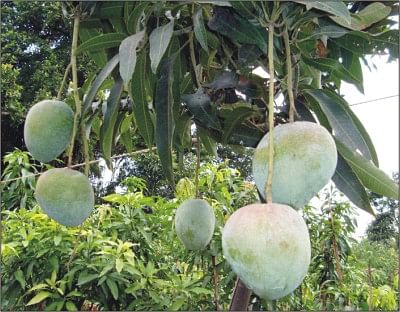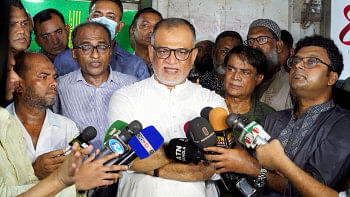<i>3 more new varieties of juicy mangoes</i>

High yielding BARI-4 is among the three recently released mangoes by the scientists at regional Horticulture Research Station in Chapainawabganj.Photo: STAR
Regional Horticulture Research Station (RHRS) at Chapainawabganj has evolved three more new varieties of mangoes.
At a farmers' training programme the RHRS scientists formally released those among the mango growers on June 17.
The varieties are BARI Aam6, 7 and 8.
The speakers at the function said, Chapainawabganj being the largest mango growing district has more than 16 lakh mango trees on 2,300 hectares of land.
The mangoes produced in the district meeting yearly demand in the country aslo deserve export to other countries, they added.
The newly released mangoes are regularly bearing and tasty, they said.
According to authorities, BARI Aam 6,7 and 8 were actually released in October last year. As that was not mango season, they formally released them this month.
With the latest three, the scientists of RHRS in the last 17 years of research have evolved seven new verities of mangoes.
Among those, two varieties belong to kancha mitha (sweet and sour) varieties, two local varieties, one American colour variety and the rest two of hybrid varieties.
There are at least 350 local varieties in the country and most of them grow in Chapainawabganj district, scientists said.
An evaluation committee from Bangladesh Agriculture Research Institute (BARI) comprising breeders, horticulturists and entomologists and pathologists tested and evaluated the seven mango varieties before being formally released.
According to Dr Shafiqul Islam, Principal Scientific Officer of RHRS, the team in their evaluation counted different qualities of the mangoes including regularity in bearing, shape, colour, size, taste, yield and resistance to disease and insects. He said that the station selected 22 varieties of mangoes from a national level mango fair held at the RHRS in 1993 and started research on them.
The seven varieties of mangoes released by RHRS are: BARI Aam 1,2,3,4,6,7 and 8.
Of them, BARI Aam 2 (Laxmannbhog) and BARI Aam 7 (Apela) are colour varieties and BARI Aam 4 is a hybrid variety.
BARI Aam 1 was released in 1995, BARI Aam 2 in 1996, BARI Aam 3 in 1999, BARI Aam 4 was released in 2003 and at last BARI Aam 6,7 and 8 were released in October in 2009.
About BARI Aam 6,7 and 8, Sorof Uddin, scientific officer of RHRS, said they are all regularly bearing fruits.
BARI Aam 6 is excellent in taste and each mango weighs 280 grams. A 12-years-old tree can yield 170 kg of mango, he said.
Although the BARI Aam 7 is of moderate taste, each mango weighs 290 grams and an eight-years-old tree can yield 160 of mangoes. BARI Aam 8 is also good in taste and its size is bigger than the other two varieties. Each mango weighs around 300 grams, he told this correspondent.
The station has already started distribution of the latest varieties, sources at RHRS said.
The Regional Horticulture Research Station was established on 100 bighas of land at Chapainawabganj town in 1985.
Its earlier name was Chapainawabganj Mango Research Centre which was supposed to conduct research only on mangoes.
The station now conducts research on variety development and protection of different plants, their cultural management and post-harvest management, said RHRS officials.

 For all latest news, follow The Daily Star's Google News channel.
For all latest news, follow The Daily Star's Google News channel. 



Comments